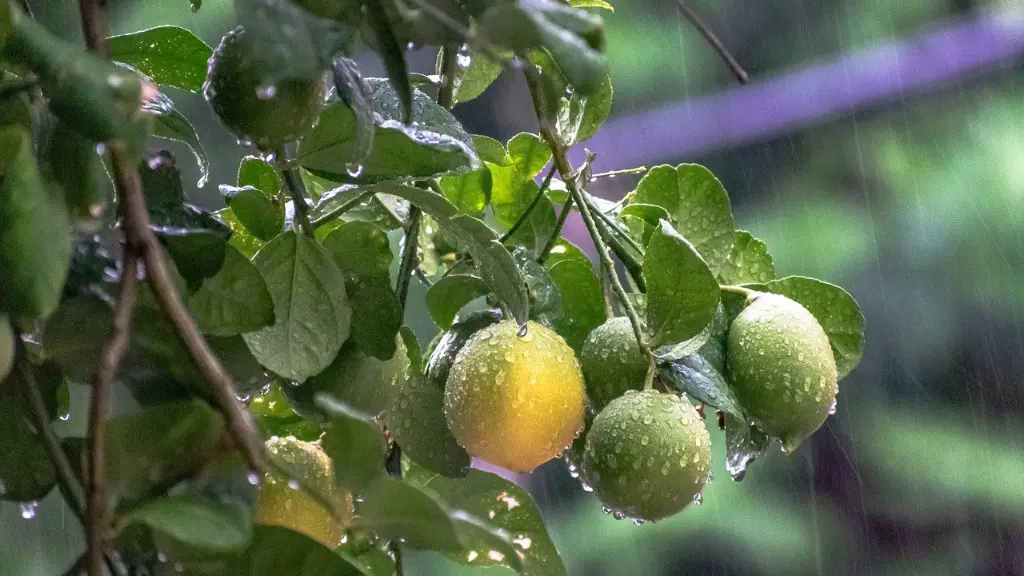Lemon trees are a great addition to any garden because of their fragrant flowers, abundance of fruit, and attractive foliage. But how long does it take for a lemon tree to produce fruit once it is planted? This article will explain the process, from planting to harvesting, so that you can start growing your own lemons in no time at all.
It usually takes anywhere from three to five years for a lemon tree to reach its full bearing size. The amount of fruit the tree produces during this period depends on its care and the climatic conditions of where it’s planted. During its first season, the tree typically produces only a few lemons; later, as the tree matures, production will increase.
Generally, lemon trees need six to eight hours of direct sunlight, moist soil, and regular feedings of nitrogen-based fertilizers. It’s important to prune the tree regularly to allow for better air circulation and light penetration; this will help promote growth and production. Planting in a deep container can also help to control moisture and oxygen levels in the soil.
For optimal growth, lemon trees need plenty of water. During the growing season, it’s best to water the tree two or three times a week, allowing the soil to dry between each watering. During the winter months, it’s best to water the tree only once a week. In hot climates, it’s important to water more often to keep the soil from drying out.
Once the tree is established and blooms, it will begin to produce lemons. Most varieties of lemon trees produce fruit year-round, but the majority of the crop will ripen between March and September. Ripe lemons can be hand-picked, or the fruit can be left on the tree to ripen further. Once ripe, lemons should be harvested as soon as possible to avoid losing any of the juice.
Growing a lemon tree can be a rewarding experience. These trees not only produce beautiful flowers and bright-yellow fruit, but they also require very little maintenance. With the right care and a bit of patience, you can enjoy delicious lemons from your own backyard for years to come.
Fertilizing and Nutrient Supply
Fertilizers and nutrient supply are essential for healthy lemon tree growth and for maximum fruit production. For organic fertilizers such as compost, mulch, or compost-tea, use them in the early spring and during the summer season. For inorganic fertilizers, it’s best to apply them during the late spring or early summer, then again in late summer. In order to ensure even nutrient distribution and absorption, use a chemical fertilizer according to the recommended instructions.
When applying chemical fertilizer, be sure to use one designed specifically for citrus trees, such as a potassium-based compound. Avoid over-applying, as this can harm the root system and cause nutrient deficiencies. Make sure to water in the fertilizer thoroughly, as this will help the tree absorb the nutrients more efficiently.
Foliar feeding is another important way to boost the nutrient levels of your lemon tree. This method involves applying liquid fertilizer directly to the leaves, allowing them to absorb the essential nutrients faster. Foliar feeding is best used in conjunction with regular fertilizing, and should be done during the early summer months when the tree is actively growing.
Finally, it’s important to test the soil regularly to determine if any changes or corrections need to be made. A soil analysis will provide a nutrient-fertilizer ratio based on the specific needs of your lemon tree, allowing you to make any necessary adjustments in order to maximize fruit production.
Winter Care
Caring for a lemon tree during the winter months is just as important as caring for it during the summer. Cold and wet weather can damage the tree’s roots and foliage, so it’s important to provide extra protection to ensure the tree’s health. During the winter months, make sure to monitor the temperature and apply extra mulch around the tree. This will help retain moisture and keep the roots warm.
It’s also important to provide adequate water during the winter months. While the soil should still be allowed to dry out between each watering, it’s still important to provide a sufficient amount of water to prevent the tree from becoming too dry. Over-watering can lead to root rot, so it’s important to strike a balance between providing enough water while avoiding oversaturation.
Frost protection is also a key part of winter care. When temperatures drop below freezing, either cover the tree with a blanket or wrap it in plastic so that the cold air is blocked. Additionally, reduce fertilizer applications during the winter months, as some chemical-based fertilizers can burn the tree’s roots when temperatures become too cold.
Finally, pruning should be done in late winter or early spring, before the new growth begins. Pruning will help the tree maintain its shape, as well as direct the growth of new branches and foliage. Make sure to use sharp tools to avoid any unnecessary damage. Prune selectively to avoid stress or shock, and avoid cutting off too much at once.
Sunlight Requirements
Lemon trees need plenty of sunlight in order to grow and thrive, so it’s important to choose a location for your tree that gets at least six to eight hours of direct sunlight each day. During the summer months, a shady spot is recommended to avoid sunburn, as too much direct sunlight can damage the tree’s foliage.
In order to ensure that your lemon tree receives enough light, it’s important to trim back any overgrown branches or nearby trees and shrubs. This will ensure that light can penetrate to all parts of the tree, increasing photosynthesis and promoting growth.
Maintaining a proper lighting balance is especially important in northern climates, where the days can be short and dark during the winter months. When possible, set up a standard indoor grow light over the tree during these months, as this will help ensure that the tree can still receive plenty of light even in the winter.
Finally, if you’re planting a lemon tree in a container, make sure to choose a pot that has either a light-colored interior or one that is opaque. This will help to reflect the light and heat, ensuring that the tree receives enough of both for optimal growth.
Pests and Diseases
Lemon trees can be susceptible to various pests and diseases, so it’s important to take steps to protect the tree from infestations. The most common pests that can affect lemon trees include tomato hornworms, green caterpillars, and citrus whiteflies. In order to prevent these pests, it’s important to regularly inspect the tree for any signs of infestation.
Another way to prevent infestations is to attract beneficial insects to the tree. Ladybugs, green lacewings, and parasitic wasps are all great options and will help to naturally keep pests away. Additionally, make sure to keep the area around the tree free of debris and weeds, as these can provide hiding places for pests.
Finally, diseases such as bacterial canker and citrus scab can also affect lemon trees. To prevent these diseases, it’s important to properly maintain the soil, water, and fertilizer balance. Pesticides and fungicides should also be applied if necessary; however, be sure to read the label carefully and use them in accordance with local regulations.
Harvesting and Storage
Once your lemon tree has produced fruit, it’s time to harvest and enjoy the juicy results of your hard work. Most lemons produce year-round, but the majority of the crop will ripen between March and September. Harvesting can be done either by hand-picking the fruit or waiting for them to drop off the tree.
Once the lemons have been harvested, they can be washed and then stored in the refrigerator in an air-tight container. To ensure that they stay fresh for as long as possible, wash the lemons before storing them, and make sure that any cuts or bruises are covered with plastic wrap to prevent mold from forming.
For longer-term storage, lemons can also be frozen. Place the washed and dried lemons in a single layer on a cookie sheet and freeze for several hours, then transfer them to a tightly sealed bag or container and keep them in the freezer for up to six months. Frozen lemons can be used in a variety of recipes, including lemonade, lemon bars, and dressings.
Finally, if you’re not planning to use the lemons right away, they can also be preserved in salt or sugar. This technique is used in many Middle Eastern and Mediterranean cuisines and is great for adding bright and acidic flavor to dishes. To make preserved lemons, slice them into quarters and place them in a shallow container with salt or sugar, then seal and store in the refrigerator for up to two months.




